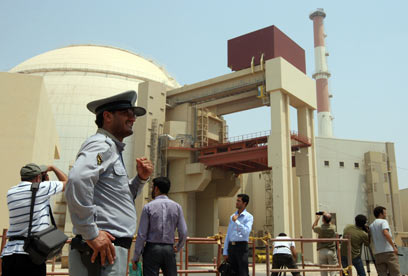
Iran's first nuclear power plant will become fully operational by early 2013, its energy minister was quoted as saying, more than two months after Russia said it was up and running normally following decades of delay.
The plant near the town of Bushehr on Iran's Gulf coast is a symbol of what Tehran says is its peaceful nuclear ambitions. The West suspects the Islamic Republic is seeking to develop a nuclear weapons capability and imposed tough sanctions on it.
Related stories:
- Iran finishes installing centrifuges in Fordo
- Iran: 2nd reactor in Bushehr by early 2014
- Russia warns against attacking Iran
However, the Bushehr reactor is not considered a serious proliferation threat by nuclear inspectors. Their main concern is focused on sites where Iran enriches nuclear fuel, in defiance of UN Security Council resolutions demanding it stop.
The reason for the apparent discrepancy on the status of Bushehr was not made clear in the comments by Energy Minister Najid Namjou, in a report carried by the English-language Iran Daily on Thursday, or whether it meant any new delay for the Russian-built complex.

Iran's first nuclear power plant in Bushehr (Photo: AFP)
Russian builder NIAEP - part of state nuclear corporation Rosatom - last month said that Bushehr would be formally "handed over for use" to Iran in March 2013, whereas earlier officials had said that would happen by the end of this year.
It was plugged into Iran's national grid in September 2011, apparently ending a protracted delay and suspicions that Moscow was using the project as a diplomatic lever. In August this year, Rosatom said it was fully operational.
Namjou was quoted in a report by Iran's semi-official Fars News Agency, published by Iran Daily, as saying the 1,000-megawatt plant would go "into operation with maximum power generation capacity" within the next two months.
"The final tests of the Bushehr nuclear power plant have been conducted," he added. Russian officials were not immediately available for comment on the report.
Last month, NIAEP director Valery Limarenko was quoted as saying by Russia's Interfax news agency: "We have taken a series of important technical engineering decisions which ... show that in order to do everything in a quality way, we have changed the (date of) the handover." He gave no details.
Iran, one of the world's biggest oil producers, says electricity generation to serve a rapidly growing population is the main motivation for its nuclear activity, which adversaries say is really aimed at developing the means to make atom bombs.
Bushehr's construction was started by Germany's Siemens before the 1979 Islamic Revolution and was taken over by Russian engineers in the 1990s.
The United States for years urged Russia - one of six world powers seeking a diplomatic solution to the decade-old standoff over Iran's nuclear programme - to abandon the project, fearing it could help Tehran develop nuclear weapons.
Those concerns were eased by an agreement under which Russia will supply enriched uranium for Bushehr and repatriate spent fuel that could be reprocessed into weapons-grade plutonium.
Refined uranium can be used to fuel power plants - Iran's stated purpose - or provide the explosive core of a nuclear bomb if processed further, which the West fears is the ultimate aim.
- Follow Ynetnews on Facebook
and Twitter
- Receive Ynetnews updates
directly to your desktop















